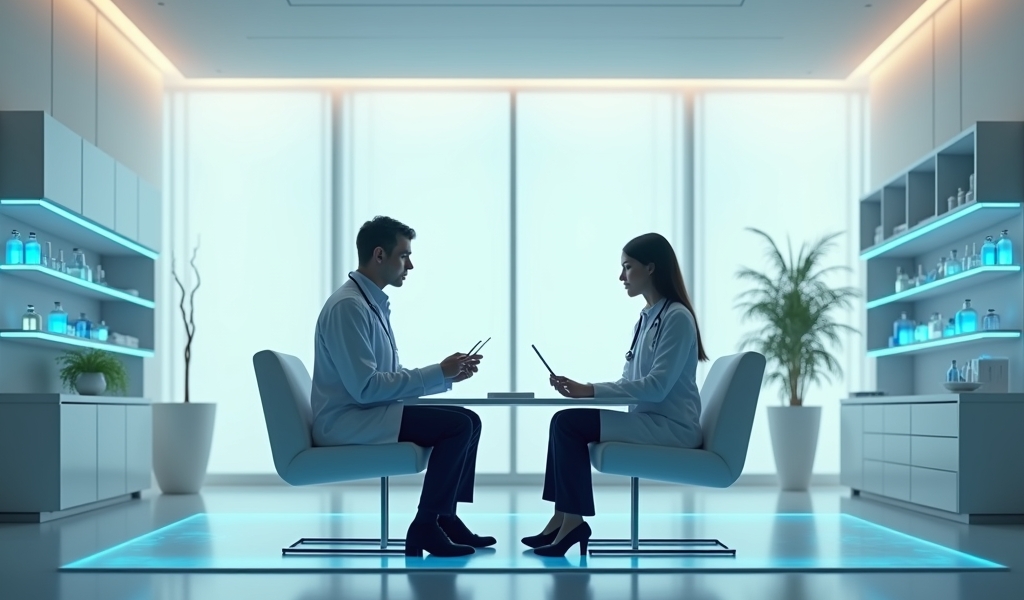Table of Contents
- Article Summary
- AI Transforming Healthcare Diagnostics
- Early Detection Saves Lives
- Addressing Global Healthcare Shortages
- Telemedicine and AI: The Perfect Partnership
- Dr Telx Approach to AI Diagnostics
- Balancing Technology with Human Care
- Conclusion
Article Summary
A recent article published by Pharmaceutical Technology highlights how artificial intelligence is revolutionizing disease detection and diagnostic accuracy in healthcare. In the article, Tore Bergsteiner, managing partner at MAIN5, discusses how AI enhances diagnostics and pathology by enabling early disease detection through advanced image analysis, which improves treatment outcomes and patient safety. He also notes that AI helps address global shortages of pathologists by improving diagnostic efficiency and accuracy. You can read the full article here: AI Boosts Early Disease Detection and Diagnostic Accuracy.
AI Transforming Healthcare Diagnostics
The integration of artificial intelligence into healthcare diagnostics represents one of the most promising developments in modern medicine. At Dr Telx, we’ve been closely following these advancements and their potential to transform patient care.
AI’s ability to analyze vast amounts of medical data with remarkable speed and precision is changing how we approach disease detection. Where human analysis might take hours or days, AI can process thousands of images or data points in minutes, identifying patterns that might otherwise go unnoticed.
This technological revolution doesn’t aim to replace healthcare providers but rather to augment their capabilities. By handling routine screenings and flagging potential concerns, AI allows medical professionals to focus their expertise where it’s most needed – on complex cases and patient care.
Early Detection Saves Lives
The value of early disease detection cannot be overstated. For conditions like cancer, cardiovascular disease, and neurological disorders, identifying warning signs in their earliest stages can dramatically improve treatment outcomes and patient survival rates.
AI-powered diagnostic tools excel at this early detection. They can spot subtle abnormalities in medical images that might be missed by even experienced clinicians. For example, AI algorithms can identify early signs of diabetic retinopathy from eye scans, detect lung nodules in CT images, or recognize patterns suggesting early-stage Alzheimer’s disease.
What makes this particularly valuable is consistency. Unlike humans, AI doesn’t experience fatigue, distraction, or variability in attention. It applies the same level of scrutiny to every image or dataset, regardless of time of day or workload – ensuring no potential warning signs are overlooked.
Addressing Global Healthcare Shortages
As Bergsteiner noted in the article, AI is helping address critical shortages of healthcare specialists worldwide. In many regions, there simply aren’t enough pathologists, radiologists, and other diagnostic specialists to meet patient needs.
This shortage leads to delays in diagnosis and treatment, which can have serious consequences for patient outcomes. By automating routine screening procedures, AI can help bridge this gap, allowing specialists to handle more cases more efficiently.
Moreover, AI can extend specialized care to underserved areas. Remote communities that lack access to specialists can benefit from AI-assisted diagnostics performed locally and reviewed remotely. This democratization of healthcare expertise is one of AI’s most promising applications.
Telemedicine and AI: The Perfect Partnership
The convergence of telemedicine and AI creates powerful new possibilities for healthcare delivery. This partnership is particularly relevant to our work at Dr Telx, where we’re committed to making quality healthcare accessible to more people.
Telemedicine removes geographical barriers to care, while AI enhances the diagnostic capabilities available through remote consultations. Together, they create a more robust platform for delivering healthcare services outside traditional clinical settings.
For example, patients can use smartphone cameras to capture images of skin conditions, which AI algorithms can analyze for potential concerns before a telemedicine consultation. Similarly, wearable devices can collect health data that AI can process to identify patterns requiring medical attention.
This integration allows for more comprehensive remote assessments than would be possible with either technology alone, bringing specialized diagnostic capabilities directly to patients, wherever they may be.
Dr Telx Approach to AI Diagnostics
At Dr Telx, we view AI as a valuable tool in our mission to provide accessible, high-quality healthcare. We believe in harnessing technology to enhance – not replace – the human elements of care that remain essential to healing and wellness.
Our approach involves using AI to support screening and triage, helping identify patients who may need urgent attention or specialized care. This allows us to allocate our clinical resources more effectively and ensure that patients with the greatest needs receive prompt attention.
We’re also exploring how AI can help us monitor patients with chronic conditions between appointments. By analyzing trends in patient-reported symptoms and health metrics, we can identify potential issues before they become serious, enabling earlier intervention.
However, we recognize that AI is just one component of comprehensive care. We maintain a strong commitment to the physician-patient relationship, using technology to strengthen these connections rather than diminish them.
Balancing Technology with Human Care
While enthusiastic about AI’s potential, we approach its implementation with thoughtful consideration of ethical implications and limitations. AI is a powerful tool, but it works best when paired with human judgment, empathy, and clinical expertise.
We believe patients deserve transparency about when and how AI is being used in their care. They should understand its role in the diagnostic process and the ways human clinicians review and interpret AI-generated insights.
Additionally, we recognize the importance of addressing potential biases in AI systems. If training data isn’t diverse and representative, AI can perpetuate or even amplify existing healthcare disparities. At Dr Telx, we’re committed to using systems developed with diverse datasets and continuously monitored for fairness and accuracy across all patient populations.
This balanced approach ensures we harness AI’s benefits while maintaining the human connection that is central to healing and trust in the healthcare relationship.
Conclusion
The integration of AI into healthcare diagnostics represents a significant step forward in our ability to detect disease early and accurately. As Tore Bergsteiner highlighted in the article, these technologies are enhancing diagnostic capabilities while helping address critical shortages in healthcare specialists.
At Dr Telx, we’re excited about the possibilities this creates for improving patient outcomes and expanding access to quality care. By thoughtfully integrating AI into our telemedicine platform, we can offer more comprehensive remote assessments, earlier detection of potential health issues, and more personalized care recommendations.
However, we remain committed to ensuring that technology serves to enhance, rather than replace, the human elements of healthcare. The future of medicine lies not in choosing between technological innovation and human connection, but in finding the optimal balance between them – using each to strengthen the other in service of better patient care.

